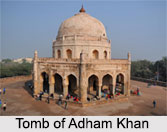 Located in Delhi among other impressive Mughal monuments, the tomb of Adham Khan is a famous landmark lying north to the Qutub Minar. Adham Khan was the younger son of Akbar"s wet-nurse Maham Anga, thus making them foster brothers. He was considered to be the part of the imperial family and was general to the Mughal Emperor. After his death, the Emperor built his tomb in the year 1561.
Located in Delhi among other impressive Mughal monuments, the tomb of Adham Khan is a famous landmark lying north to the Qutub Minar. Adham Khan was the younger son of Akbar"s wet-nurse Maham Anga, thus making them foster brothers. He was considered to be the part of the imperial family and was general to the Mughal Emperor. After his death, the Emperor built his tomb in the year 1561.
History of the Tomb of Adham Khan
Adham Khan was a nobleman and a general in Akbar"s army. Like his shrewd and ambitious mother, Maham Anga, he too sought power and was not pleased when Akbar appointed his favourite general Ataga Khan as the Prime Minister. He ended up assassinating Ataga Khan, which infuriated Akbar and ordered for his immediate execution by having Adham Khan thrown from the ramparts of the Agra Fort. Maham Anga mourned the loss of his son and went into a deep mental depression. Finally, she died of grief 40 days after the sudden demise of her son. Emperor Akbar built the tomb in Delhi to honour their memory. The tomb houses the graves of both Maham Anga and her son Adham Khan.
In 1830s, a British officer named Blake of Bengal Civil Service, converted this tomb into his residential apartment and removed the graves to make way for his dining hall. Though the officer died soon, it continued to be used as a rest house for many years by the British, and at one point even as a police station and a post office. Later, under Lord Curzon, the tomb was vacated and restored. The grave of Adham Khan was restored which lies right below the central dome, though that of his mother Maham Anga never was.
Architecture of the Tomb of Adham Khan
The tomb has an octagonal design representing an amalgamation of architectural styles of the Lodhi and the Sayyid dynasty of the 14th century. The tomb is also known as a Bhool Bhulaiya, due to its series of labyrinths where one might lose their ways in the corridors of the tomb. The mausoleum is made of reddish grey sandstone and has an uncharacteristic design from any other Mughal architecture. The tomb lies on a raised platform and is enclosed by a veranda that has 3 semi-circle openings on each side with the absence of eaves under their parapets.
Visiting Information on the Tomb of Adham Khan
The Indira Gandhi International Airport is at a distance of 13 km from the tomb. The Delhi railway station is also at a fair distance of 15 km from the tomb.



















